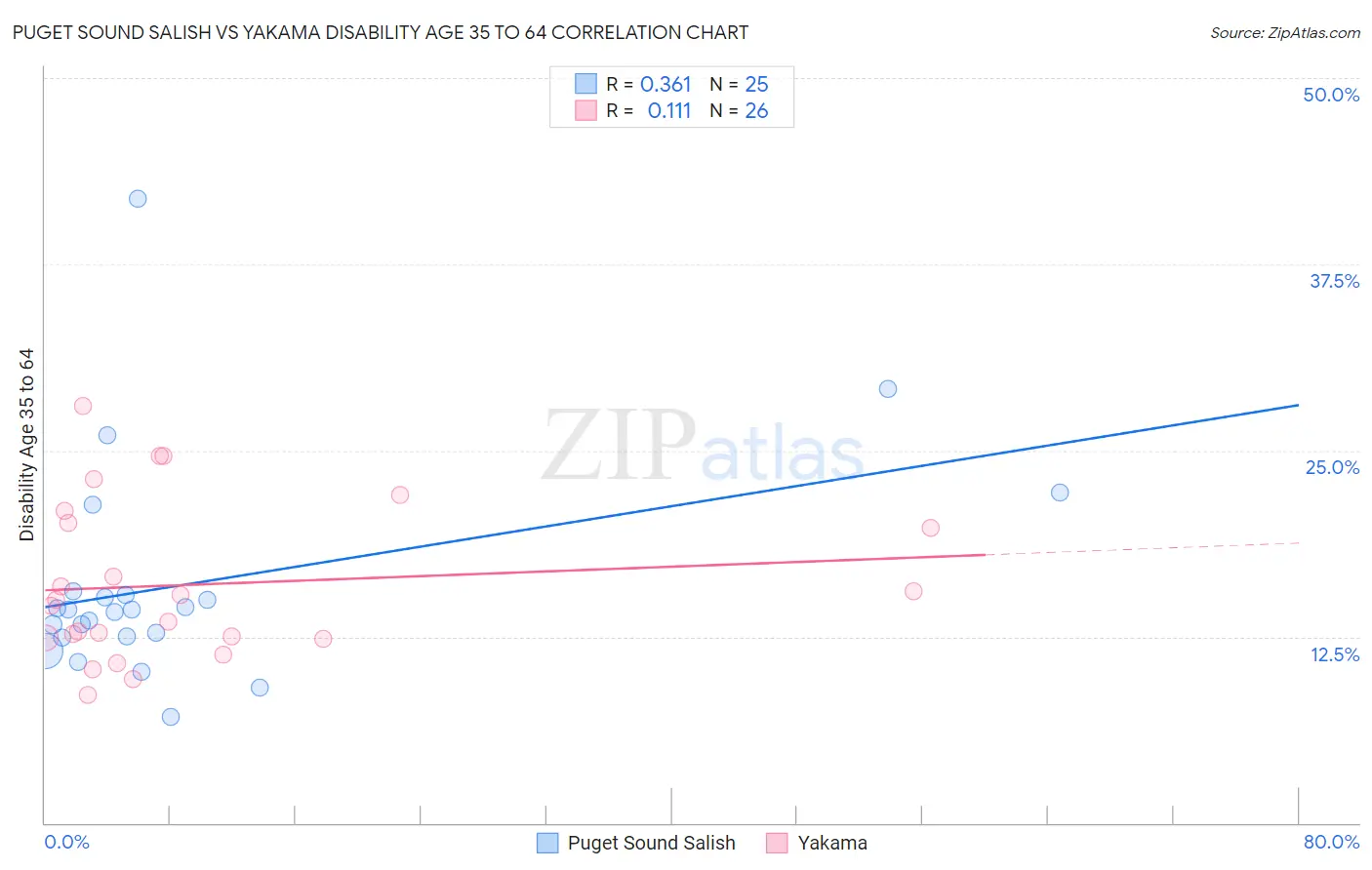Puget Sound Salish vs Yakama Disability Age 35 to 64
COMPARE
Puget Sound Salish
Yakama
Disability Age 35 to 64
Disability Age 35 to 64 Comparison
Puget Sound Salish
Yakama
13.3%
DISABILITY AGE 35 TO 64
0.0/ 100
METRIC RATING
292nd/ 347
METRIC RANK
13.6%
DISABILITY AGE 35 TO 64
0.0/ 100
METRIC RATING
295th/ 347
METRIC RANK
Puget Sound Salish vs Yakama Disability Age 35 to 64 Correlation Chart
The statistical analysis conducted on geographies consisting of 46,152,398 people shows a mild positive correlation between the proportion of Puget Sound Salish and percentage of population with a disability between the ages 34 and 64 in the United States with a correlation coefficient (R) of 0.361 and weighted average of 13.3%. Similarly, the statistical analysis conducted on geographies consisting of 19,917,759 people shows a poor positive correlation between the proportion of Yakama and percentage of population with a disability between the ages 34 and 64 in the United States with a correlation coefficient (R) of 0.111 and weighted average of 13.6%, a difference of 1.7%.

Disability Age 35 to 64 Correlation Summary
| Measurement | Puget Sound Salish | Yakama |
| Minimum | 7.2% | 8.6% |
| Maximum | 41.9% | 28.0% |
| Range | 34.7% | 19.4% |
| Mean | 16.0% | 16.0% |
| Median | 14.3% | 14.8% |
| Interquartile 25% (IQ1) | 12.5% | 12.4% |
| Interquartile 75% (IQ3) | 15.4% | 20.1% |
| Interquartile Range (IQR) | 2.9% | 7.7% |
| Standard Deviation (Sample) | 7.3% | 5.3% |
| Standard Deviation (Population) | 7.2% | 5.2% |
Demographics Similar to Puget Sound Salish and Yakama by Disability Age 35 to 64
In terms of disability age 35 to 64, the demographic groups most similar to Puget Sound Salish are Immigrants from Congo (13.3%, a difference of 0.050%), Ute (13.4%, a difference of 0.47%), Immigrants from Liberia (13.2%, a difference of 0.56%), Indonesian (13.2%, a difference of 0.64%), and Fijian (13.2%, a difference of 0.71%). Similarly, the demographic groups most similar to Yakama are African (13.6%, a difference of 0.22%), Bangladeshi (13.6%, a difference of 0.57%), Cheyenne (13.6%, a difference of 0.60%), Yaqui (13.5%, a difference of 0.68%), and Spanish American (13.7%, a difference of 0.80%).
| Demographics | Rating | Rank | Disability Age 35 to 64 |
| Central American Indians | 0.0 /100 | #283 | Tragic 13.0% |
| Immigrants | Nonimmigrants | 0.0 /100 | #284 | Tragic 13.0% |
| Immigrants | Somalia | 0.0 /100 | #285 | Tragic 13.1% |
| Hmong | 0.0 /100 | #286 | Tragic 13.1% |
| Tlingit-Haida | 0.0 /100 | #287 | Tragic 13.2% |
| Fijians | 0.0 /100 | #288 | Tragic 13.2% |
| Indonesians | 0.0 /100 | #289 | Tragic 13.2% |
| Immigrants | Liberia | 0.0 /100 | #290 | Tragic 13.2% |
| Immigrants | Congo | 0.0 /100 | #291 | Tragic 13.3% |
| Puget Sound Salish | 0.0 /100 | #292 | Tragic 13.3% |
| Ute | 0.0 /100 | #293 | Tragic 13.4% |
| Yaqui | 0.0 /100 | #294 | Tragic 13.5% |
| Yakama | 0.0 /100 | #295 | Tragic 13.6% |
| Africans | 0.0 /100 | #296 | Tragic 13.6% |
| Bangladeshis | 0.0 /100 | #297 | Tragic 13.6% |
| Cheyenne | 0.0 /100 | #298 | Tragic 13.6% |
| Spanish Americans | 0.0 /100 | #299 | Tragic 13.7% |
| Delaware | 0.0 /100 | #300 | Tragic 13.7% |
| French American Indians | 0.0 /100 | #301 | Tragic 13.7% |
| Aleuts | 0.0 /100 | #302 | Tragic 13.8% |
| Sioux | 0.0 /100 | #303 | Tragic 13.9% |